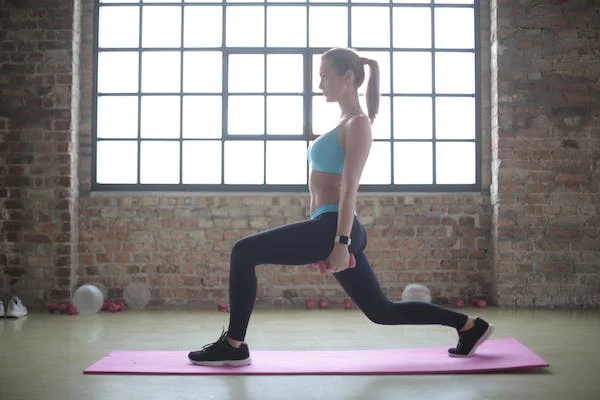
Dumbbells have been a staple in fitness for generations, offering accessibility for many to maintain physical wellness, evolving over time to fuse with various exercises to meet personal goals, such as dumbbell swings, which optimize the workout experience. This article delves into the intricacies and the 3 benefits of dumbbell swings.
What Are Dumbbell Swings?
Dumbbell swings are a dynamic exercise involving the use of a dumbbell or kettlebell to generate powerful, fluid movements. It combines strength, power, and cardiovascular benefits, offering a holistic workout experience. Unlike static exercises, swings involve a dynamic motion, engaging multiple muscle groups simultaneously.
Dumbbell swings provide an excellent method for enhancing core strength and stability, featuring a fundamental movement pattern that aids in mobilizing the thoracic spine. However, it’s crucial to ensure adequate general mobility before attempting new exercises. Avoid exercises that exceed the muscle’s range of motion. While dumbbell swings may feel unfamiliar initially, exploring new positions is essential for enhancing core and spine health, as well as overall strength and muscle flexibility. These aspects become increasingly important as you age.
Evolution of Dumbbell Swings
Originating from kettlebell training, the dumbbell swing has evolved into a staple of functional fitness. It has transitioned from an obscure exercise to a mainstream workout due to its comprehensive benefits and effectiveness in various fitness programs.
Benefits of Dumbbell Swings:
The advantages are vast, including enhanced cardiovascular health, improved strength and endurance, and the potential for fat loss. Additionally, they promote better posture, increased flexibility, and a versatile workout suitable for individuals of different fitness levels.
One notable benefit of this exercise is its minimal impact on the spine and joints. When performed with a strong and straight back, the dumbbell swing proves to be a relatively safe total body workout, delivering impressive results, even for individuals with a history of upper or lower back pain.
-
Strength and Power
Dumbbell swings enhance strength, power, and speed by necessitating continuous tightness and concentration on breath and body bracing throughout the entire range of motion. This movement also enhances grip and forearm strength due to the constant need for a firm grip. While primarily targeting hamstrings and glutes, the exercise engages the back, quadriceps, and shoulders. To prioritize strength gains, opt for lower repetitions with heavier weights.
-
Balance and Endurance
Dumbbell swings contribute to enhancing overall balance as your body works to counter the weight’s swing, resulting in significant improvements. To build endurance, opt for lighter weights and increase repetitions. Incorporating a variety of weights in your strength training can yield rapid results.
-
Burning Calories
Dumbbell swings enable a faster pace compared to exercises like frontal shoulder presses or squats, resulting in increased calorie burn over time. This exercise engages multiple muscles simultaneously, enhancing its calorie-burning effectiveness. For even more calorie expenditure, consider the single-arm dumbbell swing, which requires doubling the workout time as each arm is worked individually. Maintain balance by extending your opposite arm while following the same form as the two-arm swing.
The high-intensity nature of swings contributes to significant calorie burn. This, coupled with a controlled diet, can aid in weight loss. The combination of cardiovascular and strength benefits makes swings an efficient fat-burning exercise, aiding in shedding excess fat. Incorporating swings into a comprehensive weight loss program, alongside proper nutrition and other exercises, can maximize results.
Anatomy of Dumbbell Swings:
Understanding the Motion
The swing primarily engages the posterior chain, including the glutes, hamstrings, and lower back. It’s a hip-hinge movement where the power is generated by the hips, translating force through the body to propel the weight.
Muscles Engaged
Beyond the posterior chain, the exercise activates the core, shoulders, and forearms. The explosive motion requires stabilizing muscles to engage throughout the movement, contributing to full-body conditioning.
Dumbbell swings effectively engage and challenge both the upper and lower body, along with core muscles. This dynamic movement activates various muscle groups including hamstrings, quadriceps, pectorals, chest, traps, shoulders, and abdominals. Furthermore, the dynamic nature of the motion compels stabilizer muscles in the middle back, lower back, rotator cuff, and forearms to exert considerable effort in maintaining control.
Proper Form and Technique
Maintaining the correct form is crucial for injury prevention and maximizing benefits. This involves a strong hip hinge, controlled movement, and avoiding overextension at the top of the swing.
Dumbbell Swings vs. Other Exercises
While they may seem similar, dumbbell swings and kettlebell swings are actually distinct exercises. While both target similar muscle groups, a dumbbell swing employs a neutral grip for both hands, unlike the overhand (pronated) grip typically used with kettlebells. This variation introduces a new challenge to your muscles, making it an effective way to diversify your training regimen.
During dumbbell swings, it’s important to maintain control over the weight, unlike the more independent movement of a kettlebell swing. Dumbbells offer greater control, making them ideal for beginners familiarizing themselves with the movement and for intermediate and advanced athletes aiming to lift heavier weights than possible with a kettlebell.
Moreover, if kettlebells are unavailable, dumbbell swings can also be performed using a light barbell. Simply follow the same steps outlined below for kettlebells or barbells.
Comparative Analysis
Compared to traditional weightlifting, the swing offers a unique combination of strength and cardio benefits. Unlike static exercises, it emphasizes dynamic movement, promoting functional strength.
Advantages Over Traditional Exercises
The dynamic nature of swings not only burns more calories but also improves cardiovascular fitness. It engages more muscles, offering a full-body workout in a shorter duration.
Distinguishing Features
Different from exercises like deadlifts or squats, swings focus on explosive power generation. They emphasize speed and control, making them distinct in the fitness landscape.

Tailoring Dumbbell Swings to Your Fitness Level:
Beginner’s Guide
For newcomers, starting with lighter weights and focusing on mastering the form is crucial. This helps in preventing injury and establish a foundation for progress.
Intermediate Techniques
As proficiency improves, individuals can progress to heavier weights and explore variations such as one-arm swings or incorporating different tempos.
Advanced Variations
For experienced individuals, advanced techniques like double swings or more complex movements can be integrated, challenging even the fittest individuals.
This is just the start! There’s so much more to explore with dumbbell swings, from the science behind their effectiveness to the cultural impact they have on fitness enthusiasts.
Incorporating Dumbbell Swings into Your Routine:
Frequency and Duration
Determining how often and for how long to perform swings depends on individual fitness goals. Regular practice, typically 2-3 times a week, can yield significant results.
Combining with Other Workouts
Swings complement various workouts. They can be integrated into circuit training, HIIT routines, or used as a warm-up before resistance training.
Targeted Fitness Goals
The adaptability of swings allows customization to suit specific fitness goals, whether it’s enhancing endurance, strength, or overall fitness.
The Science Behind Dumbbell Swings:
Cardiovascular Benefits
Swings elevate heart rate, providing cardiovascular benefits similar to moderate-intensity aerobic exercises, contributing to overall heart health.
Metabolic Impact
The explosive movement of swings boosts metabolism, aiding in burning of calories and potentially supporting weight loss when paired with a balanced diet.
Muscle Activation Studies
Research demonstrates extensive muscle activation during swings, highlighting their efficacy in engaging various muscle groups concurrently.

Common Mistakes and How to Avoid Them:
Faulty Forms and Injuries
Poor technique can lead to back strains or other injuries. Educating oneself on proper form and seeking guidance from a fitness professional is crucial.
Overtraining Risks
Overdoing swings can lead to fatigue or overuse injuries. Balancing workout intensity and recovery periods is essential for overall well-being.
Tips for Correcting Errors
Revisiting form, using appropriate weights, and allowing ample rest are effective strategies to correct and prevent mistakes.
Equipment and Setup:
Choosing the Right Dumbbells
Selecting the appropriate weight is key; lighter for beginners, heavier as proficiency grows. Ensuring proper grip and quality equipment is vital.
Setting Up Your Space
Adequate space is necessary for safe swings. Ensuring a clear, non-slip surface and ample room around is essential for an uninterrupted workout.
Safety Measures
Prioritizing safety with proper footwear, maintaining a neutral spine, and being mindful of surroundings ensures injury prevention.
Injury Prevention and Rehabilitation:
Completing a Proper Warm-up
Proper warm-up routines and adherence to a personalized dietary regimen are frequently overlooked by athletes embarking on a new training regimen. While dedicating ample time to warming up may initially appear burdensome, its significance becomes evident in injury prevention and overall performance enhancement.
Proper warm-up routines and adherence to a personalized dietary regimen are frequently overlooked by athletes embarking on a new training regimen. While dedicating ample time to warming up may initially appear burdensome, its significance becomes evident in injury prevention and overall performance enhancement.
Prioritize warming up and stretching both before and after your workout to minimize the risk of injury. Ensure you never hold your breath during exercises; inhale during the easier phase and exhale during the more challenging phase. Maintain ample space to avoid contact with others during swings, and always maintain a secure grip on the weight.
Strengthening Vulnerable Areas
Supplementary exercises focusing on areas susceptible to injury, such as the lower back, can prevent injuries during swings.
Recovery and Rehabilitative Techniques
For those with injuries, swings can be reintegrated gradually after rehabilitation, emphasizing correct form and consulting healthcare professionals.
Consulting Professionals
Seeking guidance from fitness experts or physical therapists is vital for addressing existing injuries or preventing future ones.
These fundamentals are crucial for a safe and effective swing routine, ensuring optimal results without compromising safety or well-being. But there’s much more to explore, from historical contexts to debunking common myths!
Conclusion:
Executing these exercises with proper form can yield remarkable muscle gains over time. If you have access to a personal trainer, leverage their expertise to master the correct form and establish a safe, effective workout regimen.




